|
living:
our people
 Deborah Anderson: good on Paper Deborah Anderson: good on Paper
Multi-talented Deborah Anderson doesn’t just have a creative
vision: she lives it
by Elyse Glickman
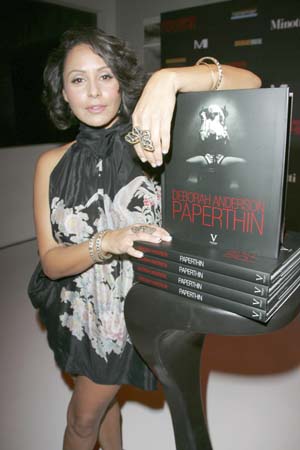
Deborah Anderson with her new book, Paperthin.
LOS ANGELES
IS famously home to many offspring of movie and music royalty.
Many of these lucky individuals reside in West Hollywood, an area
with a mix of bohemian visionary vibe and high fashion. Deborah
Anderson, who just happens to be the daughter of the wildly creative
and risk-taking Yes front man Jon Anderson, is one of its residents.
However, Deborah Anderson is far different from most
of her well heeled celebrity neighbours. You can see it in her quaint
and tidy little bungalow, which makes more of a statement about
her rather than who she hired as her decorator. Sure, there
are some requisite investment pieces (decadent raw silk-covered
couches) and antiques blended with simple tables and shelves. However,
what gives her space life—and tells you a lot about where she’s
coming from—are her expressive photographs channelling Robert Mapplethorpe
and Man Ray mixed with Asian art, crystals and family mementoes
that show her clan was not the usual rock-star–showbiz family. The
presence of Deborah’s sister’s dog, Harvey, coming out to greet
me roots everything in reality.
Harvey is closely followed by Anderson, who is tall,
elegant and casually chic, yet is fresh scrubbed and devoid of obvious
labels or bling. In a time where adult celebrity kids try to get
out from behind the shadows of famous parents, the only shadows
Deborah deals with are the ones that exist in her photos, which
she stylizes for artistic effect. Imagine that: somebody who slowly
and steadily has made a name for herself in the most authentic side
of the term.
Anderson, who serves piping hot cups of Rooibos tea
before settling down for the interview, explains she has called
West Hollywood her home for the past five years, after moving back
from Paris. ‘I lived there for three-and-a-half years,’ she says.
‘I originally moved to Paris because I had a clothing line, and
I felt the city had the right kind of energy and creative place
for me to grow æsthetically. Though 9-11 had just happened,
I originally felt it wouldn’t affect me directly. However, it did
and I found myself wanting to do something expressive with my clothing
line that was vintage-y and one of a kind. This is how I fell into
photography, styling and setting forth to capture the pieces in
a certain way.’
Prior to her stint in Paris, Anderson and her younger
siblings (Damion and Jade) went into the family business in the
1990s. This is not surprising when you consider father Jon Anderson
was as focused on the art and global range of music as he
was at making a career in the "biz". She was good at it
and still is. However, she notes that music is a part of the picture,
figuratively and literally. Her latest recording, Silence,
(melodic chill–electronica in the vein of acts like Zero7), echoes
the mood set by her first major art photography book, Paperthin
(available at deborahandersonphoto.com
and Amazon.com).
The portfolio features a mix of celebrities (Minnie Driver, Natasha
Henstridge, Fergie, Pink, Jodie Kidd and Sophie Dahl, who wrote
a short article on female sensuality for the book), models and friends
pushing the envelope of their femininity against the backdrop of
Paris.
‘In the beginning, when I told somebody I was going
to shoot flowers, she said, ‘Oh, leave that to Mapplethorpe,’ Anderson
recalls. At the time, she was making her mark as a fashion designer
with her own line, with a following that included Minnie Driver
and Nicole Kidman.
‘I was taken aback, as my aim was to have fun,’ she
continues. ‘My first photos were un-retouched images, and when I
started playing with them, I absolutely loved the effect because
you are seeing them in a very natural yet ethereal state. All the
original images from Paperthin, likewise, are shot with 3,200-speed
Ilford film and are not retouched. There is just a cleaning of specks
of dust, where today, we are so used to seeing retouched photos,
shaping and reforming people in every fashion magazine out there.
Paperthin is real, and what you see with these women is what
you get: their natural beauty. It was more about the lighting, the
make-up and the ambience of where I shot the photos rather than
the notion of perfecting the pictures. I decorated the shooting
sites and created a special world for the models to live in for
that moment, which was a lot of fun.’
For her next book, Room 23 (Daab) and other
covetable projects (such as shooting promotional shots of Elton
John), she’s opened up to digital photography and Photoshop. In
contrast to Paperthin, which she feels captures who she was
while living in Paris, Room 23 captures the photographer
she has become in LA—savvy, sharp
and wise to how a certain film or technique captures a type of light.
At the time of the interview, Anderson was focused on the launch
and promotion of Paperthin. However she did enthusiastically
shed light on the process of putting Room 23 together, which
is as much about Hollywood as Paperthin was about Paris—down
to details such as Diana Jenkins producing and the Peninsula Hotel
(where the shoots took place) hosting the party.
‘Room 23 is a fantasy,’ states Anderson.
‘Working with digital is a whole new world, where you have control
of the image’s outcome. That said, I am grateful for learning the
art of photography in Paris through the creation of Paperthin,
with an old Minolta camera, not-great lenses, and getting the best
image possible based on what is there.’
What was there for Anderson ended up being nearly 100
celebrities (including Elton John, George Clooney, Cindy Crawford,
Lisa Rinna, Sharon Stone, Dennis Hopper, Minnie Driver and Hayden
Pannettiere) shot in one hotel room over four months in Los Angeles.
Not surprisingly, she playfully likened the whole process to something
akin to the iconic Sgt Pepper’s Lonely Hearts’ Club Band album
cover. Even with the parade of A-listers coming in, she was surprised
and astounded that most of the subjects allowed her to capture them
through her lens.
‘Because I was on my own in a room (with my subjects),
and there was this open palate situation, I was free to give direction
to them,’ she says. ‘What happened from there is that the process
becomes an organic growth of the energy of myself and the subject.
On one occasion, Sharon Stone wanted to achieve a certain thing
(with her photo sitting), but then she changed her mind and trusted
me. The pictures just grew into this gorgeous final result where
she revealed more of herself than she would have had she had gone
her way. Sharon later asked me, ‘Why are you here? Why did you leave
Paris?’ I replied, ‘Because you’re here.’ That’s the bottom line.
If I had the access to the type of subjects in Paris that I do in
Hollywood, I would have stayed in Paris. Here in LA,
fascinating subjects for photos are right at your fingertips, and
we get calls on a weekly basis for celebrities interested in being
shot: it makes more sense to be here.’
Ultimately, Anderson keeps her ego and humility in
check, as she believes it is better for the creative process. ‘No
matter how good your photography is, it’s not about thinking, ‘Oh!
Look how great my photography is,’ Anderson adds. ‘It should be
more of a case of, ‘How wonderful that they trusted me, and how
wonderful they were able to give me all of themselves and allow
me to do my job over the course of the hour or two they were with
me. Doing both books, whether (models) were naked or fully clothed,
I never faced a ‘No, I do not want to do that.’ That was a very
satisfying aspect of the process—to go in there knowing what it
was that I wanted to do and get out of the situation was also important.
If had gone in there blindly, no matter how big the star, I was
never intimidated, even by George Clooney or Elton John. I am all
about having a small team, and George asked me where my crew was.
I replied, ‘I am the crew, and now you are too. Can you help me
move that light?’ He absolutely loved it.’
Though Room 23 has a drop date of March 2009,
Anderson has stayed busy with a myriad of other projects. One of
the more eye-catching ones was the images that would become the
cover of Pink’s new album, Funhouse, shot near
Death Valley. She casually draws attention to portfolios arrayed
on her coffee table with a mix of shots from Paperthin and
the Funhouse shoot, which even in their unadorned formatting,
are striking.
‘We were aiming for something very fantasy, very circus,
very playful,’ Anderson details. ‘For the cover shot, we took Pink
to the desert, and had her on a rocking horse. Getting to that shot
was also an adventure. Pink was on her motorbike while we were following
her in a car. It was so hot, and I am not sure how we made it, but
the experience was great. She’s an amazing artist on many levels,
not just as a singer songwriter, but with her energy too, and you
can feel it when shooting photographs of her. Likewise, she appreciates
my world as well. For Pink, in the case of both Paperthin
and Funhouse, everything worked because she trusted me implicitly
with the costumes, styling and final shots. Following this, I will
be art directing and doing the styling for her next video.’
Despite Anderson’s consistently serene demeanour, she’s
as busy as any other multi-tasker in Hollywood. In addition to her
day-to-day dealings with celebrities and entertainment-oriented
projects, she also firmly stays in touch with her aesthetic side
with a gig as Art Director for the New York-based Gansevoort Hotel
Group (with locations in or opening in Miami, Chicago and Las Vegas).
All photos gracing the walls at the Miami South Beach location are
her original photography, and Paperthin will be the coffee-table
book of record throughout the hotel group. While Gansevoort’s boutique
properties are designed to make well-heeled travellers feel right
at home, Anderson’s thoughts are not far from her own childhood
home, which like this hotel group, covers some impressive locales,
including London, Barbados and the south of France. However, she
stresses that although she did enjoy some of the jet-setter perks
of a rock star childhood early on, her father made sure his kids
never strayed too far from reality. And then there were times reality
took over.
‘I wouldn’t change my childhood for anything, it has
moulded and shaped me and allowed me to be the artist that I am
today,’ she says. ‘Seeing so much of the world early in my life
shaped me incredibly. There was a lot of freedom, but through it
all, Dad was and is very spiritual and had this incredible connection
to the divine. I had a choice, and decided I wanted to be connected
on that level, and have that focus that’s more spiritual like my
father’s, instead of having that “having of stuff” focus—that
was never for me. As I contemplated this, I gravitated toward my
Dad’s way of thinking and over the years all the more so. I do what
I do, as my Dad has done what he has done, because I love doing
it. I don’t do it for the outcome, but for the journey, even though
I know I have to pay my way in the world and my bills.’
For Anderson and her siblings, father always knew best
and stayed grounded, even if he was known for his ethereal vocal
stylings: ‘He never said, “Don’t take drugs,” but he always
said, “Don’t sign anything,”’ she notes. ‘He signed enough
contracts to know better. He made his share of mistakes, and today
as we’re living in such a different era, he really taught us the
important of being who we are. He also taught us that you shouldn’t
only be concerned about paying the rent, but expressing yourself
and doing the things that truly matter to you. That said, my parents
made me work for a living. I waited tables here in LA,
and I also had to make a personal decision if I wanted to live a
certain lifestyle (rock star’s daughter) involving the drugs and
the partying. I met all the kids, and they are all sadly lost and
were not guided. As I see it, my Dad didn’t cut me off, but he empowered
me to do my own thing and be responsible for it.’
Even with real world responsibilities, the Anderson
children were naturally drawn to music and follow in their father’s
footsteps, but in ways unique to their personalities. Jade had a
number-one album in Japan, signed to Sony with a huge record deal
that unfortunately ended when the company underwent changes and
she was let go from her contract. However, she bounced back with
acting and completed work on a television pilot. Damion, who did
a single in the ’90s called Close to the Hype (a nod to Yes’s
Close to the Edge), is based in London and recently completed
his first full album. Ever the process person, Anderson is bolstering
her own early experience in music via the recording studio in Dad’s
living room and singing back up on his solo albums having taught
herself the Mac Garage Band program. This in turn, brought about
her current Silence album.
‘To follow my father’s footsteps in being a singer–songwriter
was an interesting thing,’ she muses. ‘People want to hear you but
wonder if you’re any good. I am glad that I did a couple of his
songs in Europe and recorded a couple of dance tracks. Though I
was signed to A&M records in England,
Dad didn’t do anything. What a lot of people perceive on the outside
is a big fantasy. [Industry people] don’t hand you a golden key
that will open all the doors. Dad was not in that kind of position
when I decided to record. Plus there is pressure for you to be twice
as good. Since coming into (music) the first time, it has taken
me 18 years to get to this place, where I can look at myself and
think, “Yes, I am an artist.”’
Yes, Anderson is an artist, and has proved it under
her own steam and approach. Even if the media that makes her most
visible at the moment—her photography—is in the forefront, it is
still clear she has not only found her voice but uses it in a variety
of ways. Certainly, Jon Anderson would be (and probably is) most
proud!
‘I know people are quick to judge, but if I didn’t
have the ability to do what I do, I wouldn’t be where I am,’ Anderson
affirms. ‘I worked so hard to get to this place, and it has been
based on the trust established with people I see through my camera
lens and my constant focus on getting better at my work.’
For this up-and-coming creative talent, success wasn’t
a snap, but for Anderson, it has been a fascinating journey to see
what’s developed at every stage of the ongoing process. •
Add
to Del.icio.us | Digg
it | Add
to Facebook
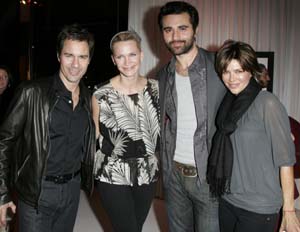
|
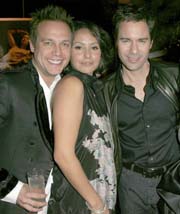
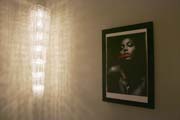
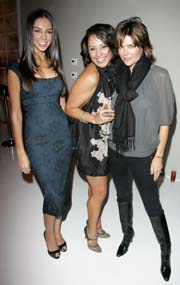
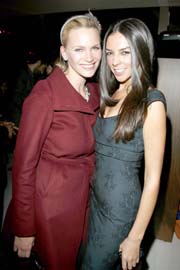
‘I know people are quick to judge, but if
I didn’t have the ability to do what I do, I wouldn’t be where I
am. I worked so hard to get to this place, and it has been based
on the trust established with people I see through my camera lens
and my constant focus on getting better at my work’—Deborah
Anderson
|

